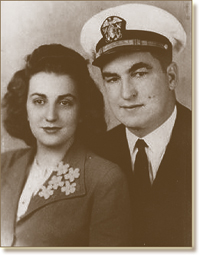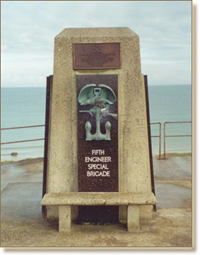Lt. Jack Hagerty II
Shortly before the 1944 invasion of Normandy, American assault forces were assured by Army commanders that as a result
of a massive air and Naval bombardment of the French coast, "every grain of sand will be turned over twice before
the first wave hits the beach." That did not happen. The following is a Veterans Day story of a U.S. Navy
Beachmaster who never came home to his wife and newborn daughter.
By Greg Olson
Journal-Courier, Jacksonville, IL - November 11, 2002
Karen Beard, of Beardstown, recently spent time with a group of heroes - men who faced death in order to save the
world from tyranny nearly 60 years ago.
Mrs. Beard has a personal connection to their story. Her uncle, Lt. j.g. Almond L. "Jack" Hagerty, a Beardstown
native, was one of the heroes who lost his life alongside those men on D-Day, June 6, 1944.
Neglected by historians and forgotten by the U.S. Navy until recent years, 30 veterans of the 6th Naval Beach
Battalion gathered in Atlanta, Ga., Sept. 26-30 to reminisce about their experiences and to remember their fellow
sailors who lost their lives on "Bloody Omaha" Beach. Among those the veterans honored was Lt. j.g. Hagerty, who
belonged to the 6th Naval Beach Battalion. The unit consisted of 363 sailors, including nine Navy doctors and 72
corpsmen who were specially trained to land on the beaches of Normandy with the first wave of invading allied
troops.
These sailors were depicted in action in the highly acclaimed Steven Spielberg movie "Saving Private Ryan." The Naval
Beach Battalions (NBBs) were represented by distinctive red markings on their helmets during the graphic opening
scene of American troops under intense fire.
Mrs. Beard said the reunion of the battalion was a moving experience for her. "I felt like I was standing in Uncle
Jack's shadow at the reunion, being there with some of the men he trained with and went to war with," said Mrs.
Beard. "As they told their stories of bravery and heroism, I knew that Jack would have been like that, too. As
(cousin) Steve (Daniel) and I entered the room at the reunion, Ed Marriott, one of the veterans, said, 'Listen up,
Hagerty's family is here.'"
For Dr. Steve Daniel, of Charleston, the recent reunion of the 6th Naval Beach Battalion provided more details
about his great-uncle.
"I learned from the men that he served with that Jack Hagerty was tough, but fair, and that he was not a prima
donna," said Dr. Daniel. "As one person told me, all of the platoon leaders (there were nine of them - all
beachmasters) in the 6th Naval Beach Battalion, including Jack, were picked because they were the type of men
that would lead their men rather than drive them. How true those words really are, since Jack was killed as he
led, not drove, his men off LCI-85 and onto Omaha Beach. Dr. Daniel said he considered himself privileged to be
able to attend the reunion and to meet the former sailors.
"They were young men, some merely boys, and on that day in June 1944, their bravery was enormous," said Dr. Daniel.
"They were asked to do so much on that day and to hear them talk about their memories and to meet them is to
encounter history. Family members of many of the veterans also attended the reunion, and it was evident they are
very proud of the men of the 6th Naval Beach Battalion. It was an honor to be in their presence. They are heroes
to all of us."
Veterans of the beach battalion last week remembered Lt. j.g. Hagerty in a telephone interview.
"ROLY-POLLY IRISHMAN"
"He was a big, roly-poly Irishman," recalled Joe Vaghi, of Kensington, Md., who was an ensign and a beachmaster during
the invasion. "I grew up with the Irish, and I have a great affinity for them. On my side of the tracks in Bethel,
Conn., it was 98 percent Irish. Jack (Hagerty) always amused me. He had a great sense of humor.
"He was the type of person that everybody liked. He had a genuine concern for his fellow sailors. I think his football
background, along with his Irish wit, made him the type of person that everyone enjoyed being around."
Mr. Hagerty was an all-American boy. He was an honor roll student and a three-sport athlete at Beardstown High School,
graduated in 1938.
He then attended James Millikin University in Decatur, where he starred on the football team.
Mr. Hagerty enlisted in the U.S. Naval Air Corps in January 1942. However, when it was discovered he had poor depth
perception, he was transferred to the U.S. Naval Reserve.
He was commissioned an ensign at the Naval Training School at Princeton University, Princeton, N.J., in June 1943.
Later that summer, Ensign Hagerty married a former Rushville woman, Edna Mae Hickerson, and early in 1944, he was
sent overseas. He was later promoted to lieutenant junior grade.
Lt. j.g. Hagerty's unit, the 6th Naval Beach Battalion, was formed in October 1943 at Fort Pierce, Fla., and
received amphibious training at Little Creek, Va.
During training at Cove Point, Md. Lt. Hagerty was commended for saving three soldiers from drowning. Acting as
beachmaster, he saw three soldiers go off the end of a landing craft's ramp and into the cold water and saved
the men, who were weighted down with equipment and were non-swimmers.
His highly specialized Navy unit also trained at Slapton Sands, England, in early 1944 and were later attached to the
Army's 5th Engineer Special Brigade in Swansea, Wales.
Duties of the 6th
On June 6, 1944, Lt. j.g. Hagerty was a beachmaster with the 6th Naval Beach Battalion. The nearly 400-man battalion
was divided into three companies, each of which had three platoons. Their job was to organize the Omaha Beach
landings in the invasion sectors code-named Easy Red, Fox Green and Fox Red.
The commander of each platoon was a beachmaster, whose duties have often been described as similar to a traffic cop
at a busy intersection, getting men and materials across the beach. The beachmaster coordinated the efforts of
hydrographic sailors for beach reconnaissance and demolition, a communications section, boat repair specialists,
a medical doctor and Navy hospital corpsmen of his platoon. The beachmaster's priority task was to control all
boat traffic coming onto the beach and arranged for the shore-to-ship evacuation of casualties.
Tragically, Lt. j.g. Hagerty never made it ashore to fulfill his mission.
"We were on deck together as we approached the beach," wrote Lt. j.g. John F. Kincaid Jr., a 6th NBB medical officer
waiting to go ashore with Jack Hagerty. "It was then the first casualties occurred, and Jack assisted me in treating
them. He turned to lead his men ashore and I moved forward to treat another casualty. At this moment a heavy shell
landed aboard, killing Jack instantly. He had left me with a big smile and an encouraging word of 'See you on the
beach.'"
Dr. Kincaid survived the invasion of Normandy only to be killed on a destroyer off Okinawa in April 1945.
The commander of the LCI (L) 85, the landing craft carrying Lt. j.g. Hagerty and about 200 other men, later described
the scene during which the Beardstown sailor lost his life. LCI(L) stood for landing craft infantry (large).
Lt. j.g. Coit Hendley Jr., wrote: "Going into the beach, this craft hit a mine, careened through a jumble of beach
defenses, and finally got her ramps down for the troops to disembark. Before the unloading was completed, crossfire
of German 88s, (artillery pieces) machine guns and sniper fire blew one ramp off, killed 15 men, wounded another
40, and set her blazing in three compartments. ... The guns seemed to concentrate on the forward part of the ship,
and so well did they do their work that unloading was stopped because it was impossible to get past the pile of
dead and wounded. Finally, a hit finished off the ramp.
... Small boats from the large transports came alongside and finished unloading the men who had not been able to get
ashore. ... The ship had a list from the water coming in through the shell holes. ... The ship had been hit about 25
times. ...There is no need to describe all the pitiful cases. They were there and no one will ever forget.
 Back to Top
Back to Top







